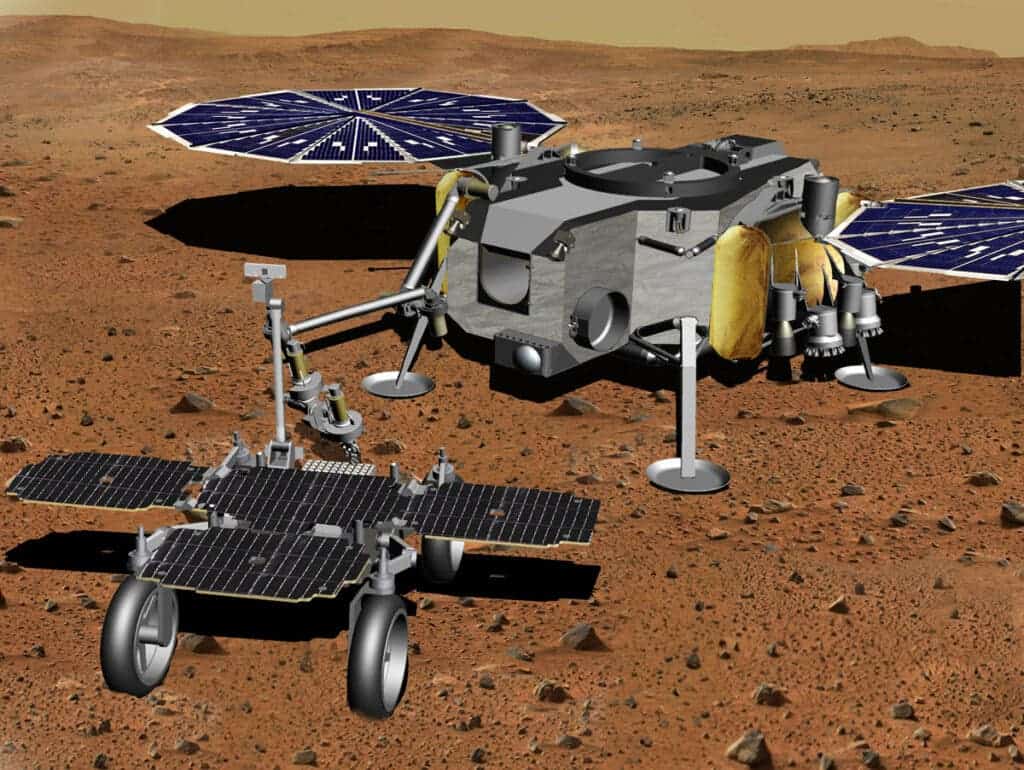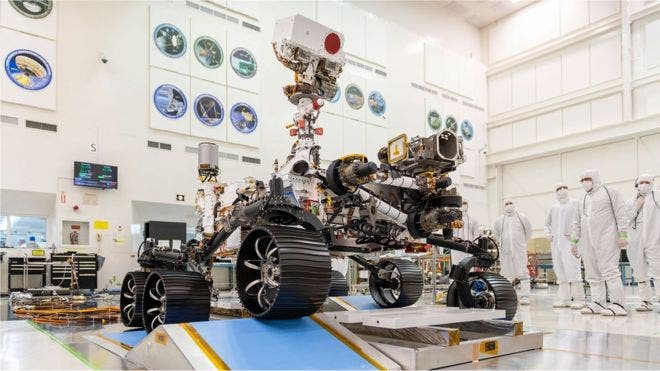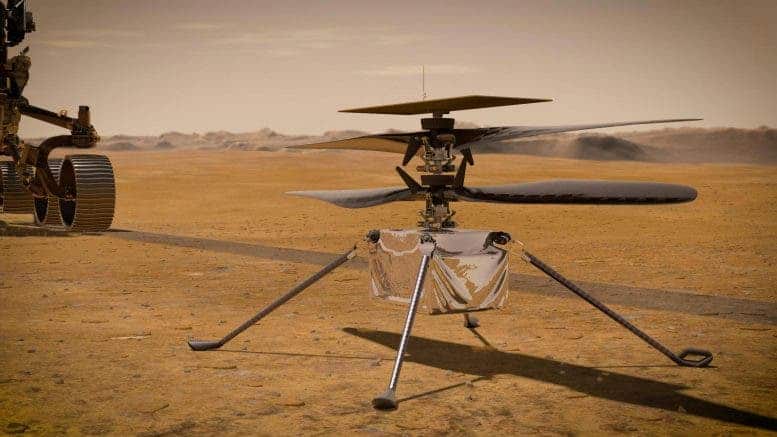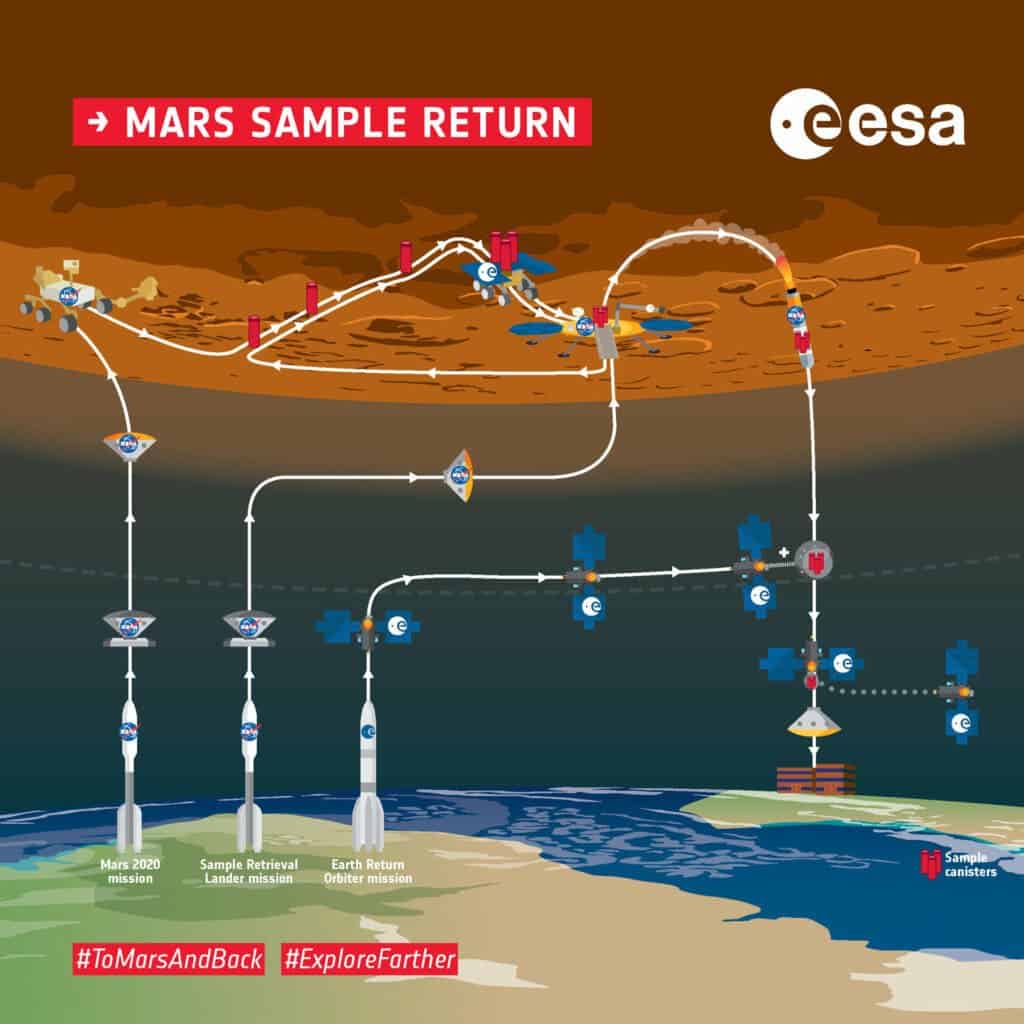
If everything goes well, Martian rocks will hypersonically pancake themselves into the Utah desert.
But first, lets start from the beginning.
When Swati Mohan was in the third grade, the television show Star Trek: The Next Generation changed her life. One episode, in particular, displayed an artist’s rendition of everything space had to offer – stars, nebulas, and galaxies. From that moment on, she knew she had to be a part of something bigger than herself.
Now, years later, she is one of the primary actors in a project which could potentially change how we look at Mars, and space in general. From that third-grader, she has risen to become the lead of Guidance, Navigation, and Control Operations for the Perseverance Rover.
The Volvo-sized Perseverance (aka the 2020 Rover) and her sidekick, the helicopter Ingenuity, are the first stages of NASA’s sample return project. If all goes as planned, the duo will be landing at the Jezero Crater in February 2021.
Jezero Crater is a 28-mile-wide (45-kilometer) crater on the western edge of Isidis Planitia, a giant impact basin just north of the Martian equator. Between three to four billion years ago, a river there flowed into a body of water the size of Lake Tahoe, depositing sediments packed with carbonite minerals and clay. The Perseverance science team believes this ancient river delta could have collected and preserved organic molecules and other potential signs of microbial life.
“So the mission can be thought of in three separate phases,” Mohan told ZME Science. “One is launch cruise that’s getting from the surface of the Earth to Mars. The second phase is Entry, Descent and Landing (EDL) from basically the top of Mars all the way down to the surface of the ground safely. The third mission is the surface mission. The actual portion where we drive around and do science is so complicated that in each of those phases there are separate missions, separate vehicles with all different hardware and software that goes along with it. You can think of it as each one of those phases has the complexity of a whole mission in it of itself.”
The returned samples have the potential to “change our understanding of the origin, evolution and distribution of life on Earth and elsewhere in the solar system,” Thomas Zurbuchen, associate administrator for NASA’s Science Mission Directorate, said in a July 28 news conference.
If successful, the Mars Sample Return (MSR) Campaign will bring samples of Martian rocks and soil back to Earth, where they can be investigated in detail, using all the capabilities of terrestrial laboratories. The return program is part of an even larger Mars Exploration Program, a long-term effort of robotic exploration of the Martian planet.
Perseverance

The nuclear-powered Perseverance is the first rover to bring a caching system to Mars that will package samples for return to Earth by a future mission. Rather than pulverizing rock the way Curiosity‘s drill does, Perseverance’s drill will cut intact rock cores that are about the size of a piece of chalk and will place them in sample tubes that it will store until the rover reaches an appropriate drop-off location.
Built at the Jet Propulsion Laboratory (JPL), the rover is loaded with all sorts of scientific instruments, advanced computational capabilities for landing and other new systems. With a chassis about 10 feet (3 meters) long, Perseverance is also the largest, heaviest robotic Mars rover NASA has ever built.
The demanding science goal requested of the rover requires a new suite of instruments to tackle the question from many angles. While, at first glance, it may look like Perseverance wears the same uniform as Curiosity, it does contain a few improvements.
“Perseverance actually takes a lot of heritage from the Curiosity rover,” said Mohan. “The cruise stage that we’re flying is very similar. The EDL system is very similar. We’ve made some upgrades to Perseverance in order to improve our entry, descent and landing performance. And the rover shares the same kind of fundamental structure and body but it has all new set of instruments that are geared for searching for biosignatures.”
Among the technologies aboard Perseverance mission is the rover’s Terrain-Relative Navigation system (TRN). Part of the landing system, TRN is the primary reason Perseverance can explore a place like Jezero. It will enable the rover to quickly and autonomously comprehend its location over the surface and modify its trajectory during descent. This will be able to provide invaluable assistance for both robotic and crewed missions landing on the Moon and is a must for future robotic and crewed exploration of Mars.
Engineers have also given Perseverance more self-driving smarts than any other rover, allowing it to traverse more ground in a day’s operations without having to wait for engineers on our home planet to send up instructions. Calculated over the length of the mission, this lack of turn-around time will translate into more science.
The Scanning Habitable Environments with Raman & Luminescence for Organics & Chemicals (SHERLOC) instrument, which can detect organic matter, and the Planetary Instrument for X-ray Lithochemistry (PIXL), which measures the composition of rocks and soil, will allow Perseverance to map organic matter, chemical composition and texture together at a higher level of detail than any Mars rover has done before. These instruments — two of the seven total onboard — will play a particularly important role in Perseverance’s search for potential signs of life.
Perseverance also carries a technology demonstration coined the Mars Oxygen In-Situ Resource Utilization Experiment — or MOXI, because what is science without a good acronym. This instrument will produce oxygen from Mars’ carbon dioxide atmosphere, demonstrating a way that future explorers might produce oxygen for rocket propellant as well as for breathing. The Mars Environmental Dynamics Analyzer (MEDA) was also created with future human exploration in mind. MEDA will provide information about the current martian weather and climate, as well as the nature of the dust on the surface. The Mars Science Laboratory Entry, Descent and Landing Instrumentation 2 (MEDLI2) package, a next-generation version of what flew on the Mars Science Laboratory mission that delivered the Curiosity rover, was also geared for future human exploration in mind, providing data about the entry and descent of the spacecraft through the atmosphere.
At one time, cameras were considered a waste of space on planetary explorers. Who would want to see images when there was so much science which could take up that space on the vessel. Thank God, those arguments have past for those of us who like to visually see the planetary landscapes (and for those of us who might want Martian backgrounds on their computer desktop…not naming names).
Perseverance is carrying the most cameras in any craft in the history of interplanetary exploration. The rover has 19 cameras that will deliver images of the landscape. The other parts of the spacecraft involved in EDL carry four additional cameras, potentially allowing engineers to put together a high-definition view of the landing process after the rover safely touches down on Mars.
Ingenuity

And what is a superhero without its trusty sidekick.
For Vaneeza Rupani, a high-school student in Northport, Alabama, second place didn’t turn out to be that bad. Rupani originally submitted the name Ingenuity for the Mars 2020 rover, before it was named Perseverance, but NASA officials recognized the submission as a terrific name for the helicopter, given how much creative thinking the team employed to get the mission off the ground so to speak.
“The ingenuity and brilliance of people working hard to overcome the challenges of interplanetary travel are what allow us all to experience the wonders of space exploration,” Rupani wrote. “Ingenuity is what allows people to accomplish amazing things.”
“It’s super cool,” said Mohan of Ingenuity. “The Mars Pathfinder mission in 1997 had a little rover called Sojourner and it was not even the size of a cereal box, and it was an add-on. That rover is the genesis of how we have the Perseverance rover now and all this complexity and capability so it’s super exciting that we’re taking that next step with ingenuity to do the first powered flight.”
Ingenuity is what is known as a technology demonstration – a project that seeks to test a new capability for the first time, with limited scope. Previous groundbreaking technology demonstrations include the Mars Pathfinder rover Sojourner and the tiny Mars Cube One (MarCO) CubeSats that flew by Mars in 2018.
Ingenuity features four specially made carbon-fiber blades, arranged into two rotors that spin in opposite directions at around 2,400 revolutions per minute – many times faster than a passenger helicopter on Earth. It also has innovative solar cells, batteries and other components. However, the little chopper doesn’t carry science instruments and is a separate experiment from Perseverance.
Because the Mars atmosphere is 99 percent less dense than ours, Ingenuity has to be light, with rotor blades that are much larger and spin much faster than what would be required for a helicopter of Ingenuity’s mass here on Earth.
Temps are another experiment with the little ‘copter. Nights at Jezro dip down much cooler than cardigan weather at minus 130 degrees Fahrenheit (minus 90 degrees Celsius). While Ingenuity’s team on Earth tested the helicopter at Martian temperatures and believes it should work on Mars as intended, the cold will push the design limits of many of Ingenuity’s parts.
In addition, flight controllers at JPL won’t be able to control the helicopter with a joystick. Like all our Martian rovers, commands will need to be sent well in advance, with engineering data coming back from the spacecraft long after each flight takes place. In the meantime, Ingenuity will have a lot of autonomy to make its own decisions about how to fly to a waypoint and keep itself warm.
NASA officials say that Ingenuity is intended to demonstrate technologies needed for flying in the Martian atmosphere. If successful, these technologies could enable other advanced robotic flying vehicles which might be included in future robotic and human missions to Mars. They are hoping what is learned through a helicopter could offer a unique viewpoint not provided by current orbiters high overhead or by rovers and landers on the ground, provide high-definition images and reconnaissance for robots or humans and enable access to terrain that is difficult for rovers to reach.
“The Ingenuity team has done everything to test the helicopter on Earth, and we are looking forward to flying our experiment in the real environment at Mars,” said MiMi Aung, Ingenuity’s project manager at JPL. “We’ll be learning all along the way, and it will be the ultimate reward for our team to be able to add another dimension to the way we explore other worlds in the future.”
Sample Return Mission
The ultimate dream for those interested in space science is finding life on another planet. That starts with sample return missions. Perseverance is that first step.
Three launches will be necessary to accomplish landing, collecting, storing and finding samples and delivering them to Earth.
Once soil samples are collected by the rover, it will deposit samples in tubes at select locations, called depots, which will be collected at a later date by the European Space Agency’s Earth Return Orbiter.
“The lander goes, lands near one of these depots, and collects the samples which have been placed on the surface,” explained Dave Spencer, the Mars Sample Return Campaign Mission Manager at JPL, in an interview. “The lander has a European rover onboard, called the sample fetch rover. This rover will be placed on the surface we’ll go out and grab the samples from this depot, bring it back to the lander and put them in an orbiting sample container, which is basically a soccer ball sized container, then put into the Mars Ascent Vehicle on the lander, that can launch it up into Mars orbit.”

As currently envisioned, the lander that will gather the samples launches in 2026 and arrives at Mars in 2028, touching down close to the Mars 2020 rover near Jezero Crater. It deposits the fetch rover to pick up the stashed samples and transfer them to the rocket. Another option is for the Mars 2020 rover to retain some of its collected samples onboard and deliver those samples directly to the rocket. The rocket would then become the first ever to launch off another planet, transporting the sample return container into orbit around Mars.
“We also designed it so that the Mars 2020 rover, assuming it’s still alive, if it’s still got more samples onboard, it can come up and provide samples to be loaded into the orbiting sample container as well,” said Spencer. “So we can receive samples from either the fetch rover or the 2020 rover.”
That’s where a separate orbiting spacecraft, provided by ESA and also launched from Earth in 2026, would rendezvous with the sample return container and ferry it back to Earth.
A NASA-provided payload on the orbiter would provide the capabilities needed to capture and contain the samples, placing them in an Earth entry vehicle that would land the samples safely on U.S. soil.
Spencer explains:
“So now we’ve got this orbiting sample container, the soccer ball-sized container that’s been delivered by this Mars ascent vehicle into Mars orbit. And it’s going to be up at around 300 kilometers (186 miles) of altitude above the surface of Mars. And the European orbiter, this Earth Return Orbiter is going to go up and autonomously rendezvous and capture this orbiting sample container. And once it captures, there’s a big canister basketball hoop basically, that we steer the vehicle such that the orbiting sample contains canister goes into this basketball hoop, close the door on and capture it and then very carefully put it through a robotic process.”
The canister will contain all of the materials inside the orbiting sample container. However, scientists need to be careful not to return any uncontained material back into the Earth’s biosphere, such as dust on the canister. In order to keep this from occurring, the capsule contains a redundant containment system where the engineers put a containment vessel around the orbiting sample canister, and then turn around and put that unit into another containment vessel.
“Now we’ve got this enclosed set of samples and we put them into an earth Earth entry vehicle that gets delivered back to Earth. It’s then on put on an impact trajectory, so it’s actually going to crash land in Utah. And it comes in directly from the interplanetary trajectory. So it’s going to be coming in at hyper-sonic speeds through the Earth’s atmosphere and impact in the mudflats at a place called the Utah test and training rage.”
And then if all goes well, it will be recovered intact.
And if all goes better, we will make some amazing discoveries. Hopefully, discoveries that will propel us to search for sample returns on further bodies in the future.
As Alex Mather of Lake Braddock Secondary School in Burke, Virginia, eloquently wrote in his winning essay naming the Perseverance rover, “We are a species of explorers, and we will meet many setbacks on the way to Mars. However, we can persevere. We, not as a nation but as humans, will not give up.”


